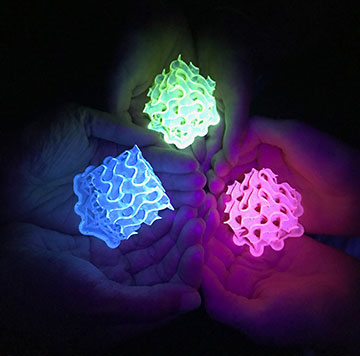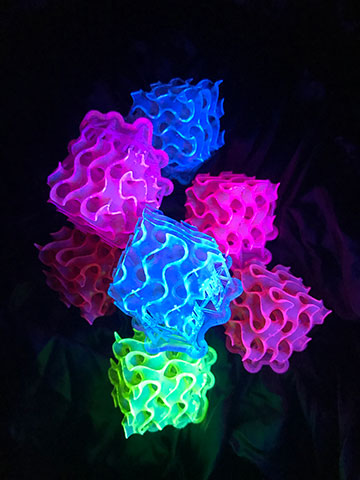
Glowing 3D-printed gyroids made with bright SMILES materials. [Credit: Amar Flood]
Despite the known existence of over 100,000 fluorescent dyes, the creation of a solid optical material has remained largely elusive. Packing dye molecules together in a solid state results in emission quenching due to electronic coupling, rendering the materials dim and ineffective.
Now, researchers from the U.S. and Denmark have finally solved this 150-year-old problem to produce what they report is the brightest fluorescent solids ever made (Chem, doi: 10.1016/j.chempr.2020.06.029). The class of materials they describe, called small-molecule ionic isolation lattices (SMILES), allows for the crystalline packing of dye molecules with spatial and electronic isolation.
Hierarchical self-assembly
Amar Flood, James F. Jackson Professor of Chemistry at Indiana University, USA, and his colleagues focus on developing new materials using hierarchical self-assembly. This synthetic strategy starts with an initial structural motif that can further self-assemble to create a complex of molecules bonded together.
From this perspective, they decided to tackle the long-standing issue of transferring the fluorescent properties of dyes to solids. In particular, the researchers wanted to come up with a predictable, plug-and-play method that could be used directly with commercially available dyes without any preprocessing.
“It has been known for a while that the dyes just need to be pushed further apart from each other so they can regain their behaviors as individuals—just as they once were when diluted out in solution,” said Flood. "But the trick to making it universal was to use the rules of hierarchical self-assembly plus a little luck.”
Best and brightest

A stack of gyroids glows in the dark thanks to SMILES materials. [Credit: Amar Flood]
When dye molecules stand shoulder-to-shoulder inside a solid, they electronically interfere with one other and open dark states that dump any absorbed light out as heat. To force social distancing, the researchers combined a cationic dye—which come with counter anions for charge balance—with unique molecules called cyanostars, created by Flood’s group in 2013.
The doughnut-shaped, colorless cyanostars trap the counter anions in their holes, making them negatively charged, and they assemble themselves into a checkerboard pattern with the cationic dye molecules. Flood and his colleagues found that these ionic lattices, which they dubbed SMILES, placed the dyes a regular distance apart and allowed them to fully fluoresce as individual molecules.
“When we went down that pathway [of hierarchical self-assembly] and found that we had discovered a general basis for the creation of fluorescent materials—one that works with many of the major dye classes—we realized that they were the brightest on record,” Flood said.
Applying SMILES
They verified the brightness of SMILES materials with various commercial dyes, finding that the properties of cyanostars enabled them to plug in almost any cationic dye with ease. Going a step further, the researchers prepared fluorescent samples of industrial polymers and plastics with SMILES by extrusion and compounding bulk materials.
“We expect areas using fluorescence technology to benefit from this new material,” Flood said. “This includes solar concentrators for improved solar cells, solid state lasers for medical applications and contrast/labeling reagents for faster and more efficient diagnostics and drug development.”
